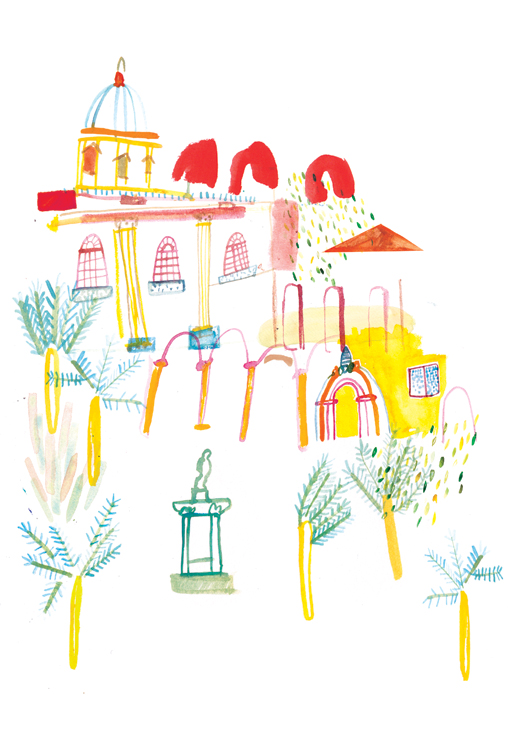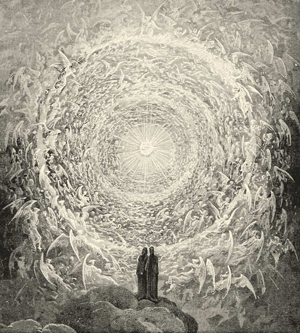ZERODUEZEROSEI

text Giampiero Sanguigni
photos Federica Verona
Le Città e le Persone
Mi piacciono le città e le persone capaci di raccontare storie.
Mi piacciono le città e le persone con un passato drammatico.
Mi piacciono le città e le persone con un’anima nascosta.
Mi piacciono le città e le persone che si vestono in maniera colorata.
Mi piacciono le città e le persone bipolari.
Mi piacciono le città e le persone inconsapevoli del loro potenziale.
Mi piacciono le città e le persone che non si lasciano conoscere facilmente.
Mi piacciono le città e le persone che non sono condizionate dalla loro storia.
The cities and peoples
I like the city and people that are able to describe a story.
I like the city and people with a dramatic past.
I like the city and people with a hidden soul.
I like the city and people who dress colourfully.
I like the city and people that are bipolar.
I like the city and people unaware of their potential.
I like the city and people that slowly unveil.
I like the city and people that are not influenced by their own story.
Sottopasso
Nel sottopasso della stazione Trastevere un venditore indiano ha riempito una parete di farfalle di carta. Sono tutte uguali ma di colori diversi, equidistanti, compongono un ampio e perfetto rettangolo variopinto. L’indiano non ha acquirenti. L’opera andrebbe comprata per intero, nessuno se la sente di creare un vuoto in quella tessitura colorata.
Subway
In the subway station of Trastevere an Indian seller has filled a wall with paper butterflies. They are all the same but of different colors, equidistant, they make up a large and colorful perfect rectangle. The Indian has no buyers. The work should be purchased in full, no one feels like creating a hole in that colourful weaving.
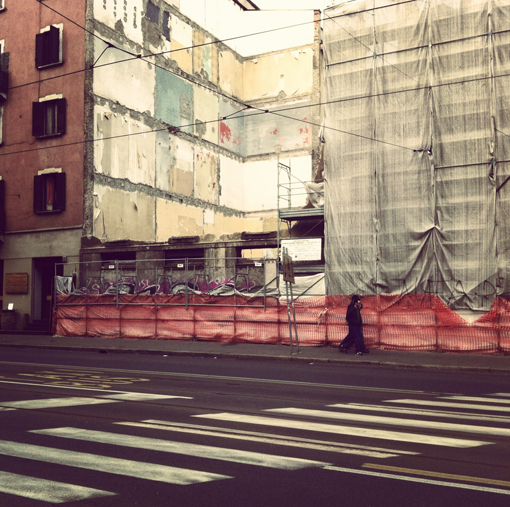
Una cornice rossa
L’altro giorno ero vicino alla stazione. Ho incontrato una signora di circa sessant’anni, in piedi su una scala, di quelle che si usano in cucina per raggiungere i ripiani più alti. Aveva una macchina fotografica e stava facendo una foto. Da quell’altezza poteva guardare attraverso un buco, uno dei tanti fori regolari della recinzione di un cantiere. Attraverso la plastica rossa inquadrava i graffiti realizzati sul muro di fronte. La mia mente ha ricostruito la scena dello scatto: una cornice rossa e un soggetto variopinto. Non sapevo se fosse più astratta la foto o lei in mezzo ai passanti indifferenti.
A red frame
The other day i was near the station. I met a lady of about sixty, standing on a ladder, the kind that you use in the kitchen to reach high shelves. She had a camera and was taking a photo. From that height she could look through a hole, one of the many regular holes in the fence of a construction site. Through the red plastic she was gazing at the graffiti on the opposite wall. My mind has reconstructed the scene of the shooting: a red frame and a colorful subject. I did not know what was more abstract, the photo or the lady in the midst of indifferent passers-by.
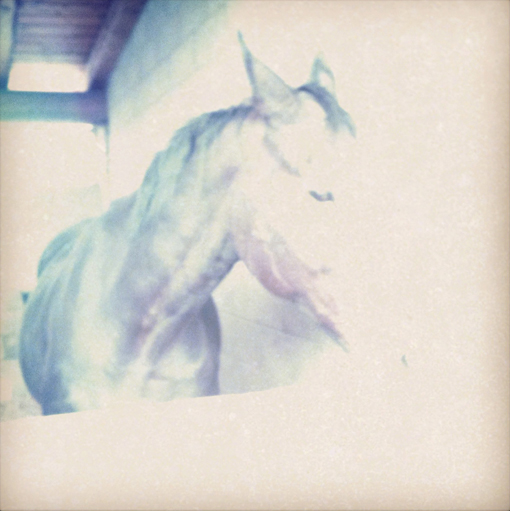
Ready Made
Le stampelle di metallo come ganci con cui rovistare nei cassonetti.Gli sportelli delle cabine dell’Enel come bacheche pubbliche:traslochi, sgombero cantine. Le lenzuola come sacco per spostare il più velocemente possibile le borse e scappare dalla Finanza.I contenitori di cartone della Coca Cola come portamonete.I carrelli della spesa come passeggini.Le scatole di cartone come bancarelle per gli occhiali da sole.Le cabine tecniche dei semafori come ripostigli per tergicristalli e sapone.
Ready made
Metal crutches used as hooks to rummage in the bins. Enel’s cabin doors like public boards: removals, cellar clearings.Sheets to use as sacks to gather the bags and escape from the tax police as quickly as possible. Cardboard coca cola containers to use as a wallet.Shopping carts used as strollers.Cardboard boxes as stalls for sunglasses.Traffic light service cubicles as closets for windshield wipers and soap.
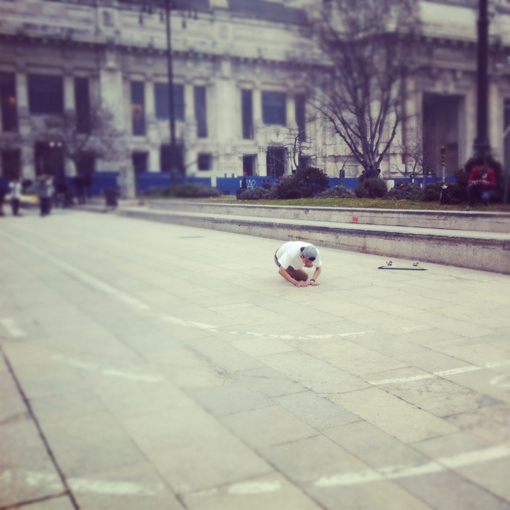
Via Acaia
Oggi ero fermo nel traffico. La potatura di alcuni alberi su via Magna Grecia aveva creato una coda di auto isteriche per diverse centinaia di metri, fino a via Acaia. Nella confusione mi è passato a fianco un cavallo, tenuto per le briglie da una ragazza che, a piedi, lo guidava attraverso l’ingorgo. Mansueto, quasi fosse una cane al guinzaglio, ma alto quanto le insegne dei negozi.
Via Acaia
Today I was stuck in traffic. The pruning of some trees on Via Magna Grecia had created a queue of hysterical cars for several hundred meters to Via Acaia. In the confusion, a girl walked past me, she was holding the reins of a horse and was guiding it through the traffic jam. Gentle, almost like a dog on a leash, but as high as shop signs.
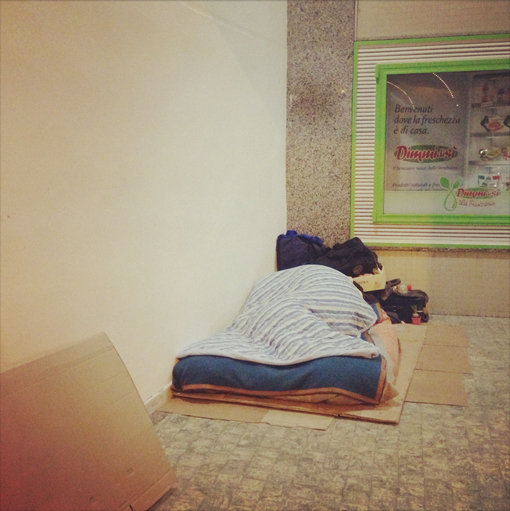
Il numero civico
Ieri mattina presto sono uscito di casa. Di fronte al portone, proprio sotto il citofono del condominio, c’erano due operai. Stavano rompendo il marciapiede. Scalpellavano un foro quadrato, della dimensione di un sampietrino. “C’è qualche problema?” faccio io, “Disposizioni del comune” rispondono loro. Me ne sono andato senza fare commenti. La sera, tornando a casa, mi sono fermato a guardare il buco. Era lo stesso della mattina, ma riempito con del cemento. Oggi incontro la mia vicina del primo piano.
“Hai visto che è successo ieri?”.
“No”, le rispondo.
“Ieri sentivo ‘na confusione. Me so affacciata alla finestra e c’erano i viggili, quelli con la telecammera e la gente che piagneva. Tutti di fronte ar citofono”.
“Cos’era successo?” faccio io.
“So ‘scita pe chiedello a quelli d’er comune. M’hanno detto che durante la guera qua c’era una che era stata deportata nei campi de concentramento. Stavano facendo ‘na specie de cerimonia e avevano messo un sampietrino commemorativo de bronzo”.
“Davvero?” dico io.
“Ma infatti no!” commenta lei e aggiunge: “Gli ho spiegato che nunn’era possibbile, perché il condominio nostro durante la guera è stato bombardato”.
“E loro cos’hanno risposto?”.
“Il vigile allora ha telefonato in comune…” , “E…?”, “…’o sai ch’era successo?”.
”No…”. “S’erano sbajati de civico! Così hanno smontato er sercio commemorativo e so ‘nnati a piagne cento metri più avanti”.
The civic number
Yesterday morning I left home. In front of the door, just below the intercom of the building, there were two workers. they were breaking the pavement. they were chiselling a square hole, the size of a sampietrino.
“Is there a problem?” I ask,
“town council disposition “ they reply.
I left without comment. In the evening, on the way home, I stopped to look at the hole. It was the same as in the morning, but filled with cement. Today I meet my neighbor who lives on the first floor.
“Did you see what happened yesterday?”.
“No,” I reply.
“Yesterday I heard a lot of confusion so I looked out the window, there were police officers and people with television cameras and other people crying.
All in front of the intercom..”
“What happened?” I ask.
“ I went out to ask the council officers what was going on. They told me that during the war someone, that was then deported to the concentration camps, used to live here. They were having a ceremony and a bronze sampietrino was being laid to commemoratethe event”.
“Really?” said I.
“of course not!” she replies
and answers: “I told them it was impossible ‘cause our apartmente block had been bombed during the war”.
“and what did they answer?”.
“the officer phoned the town hall…..”, “and…?”,
“… do you know what happened?”.
“no….” “They had the wrong address! so they took out the commemorative bronze slab and went and cried a hundred meters further up the street”.

